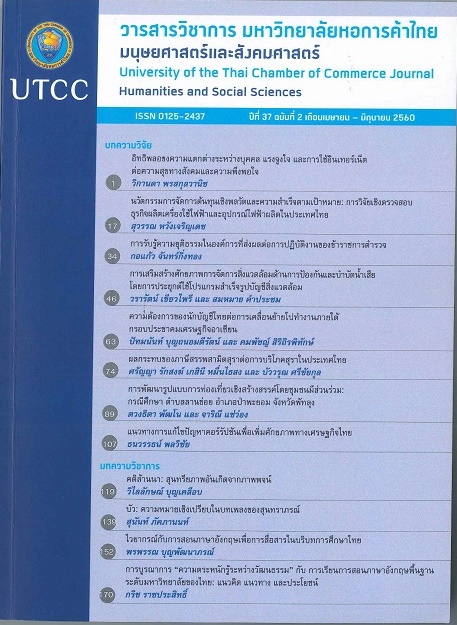Integrating “Intercultural Awareness” with Thailand’s Tertiary General English Instruction: Concepts, Guidelines and Advantages
Main Article Content
Abstract
Globalization has changed the way people interact due to the rise of intercultural communication, the increased number of interactions among non-native English users, and the diversity of the cultural backgrounds of non-native English users. However, intercultural awareness (ICA) which is a part of intercultural communicative competence (ICC) is typically neglected in English language courses. In addition, English language teaching (ELT) seems to emphasize mastery of features such as lexis, phonology and syntax, as well as expanding the vocabulary of the students. This article aims to review and discuss the concepts of ICC and the current situation
of ELT; to describe how to integrate ICA into English language courses, and reasons to do so; provide guidelines on how to design such a course, and to outline the learning advantages in accordance with the suggestions. The guidelines herein would be beneficial to course designers who need to develop and provide their students, in particular, Thai students at the tertiary level, with the qualifications which meet the urgent needs of the present century.
Article Details
ลิขสิทธิ์ของบทความ
ผลงานที่ได้รับการตีพิมพ์ถือเป็นลิขสิทธิ์ของมหาวิทยาลัยหอการค้าไทย ห้ามมิให้นำเนื้อหา ทัศนะ หรือข้อคิดเห็นใด ๆ ของผลงานไปทำซ้ำ ดัดแปลง หรือเผยแพร่ ไม่ว่าทั้งหมดหรือบางส่วนโดยไม่ได้รับอนุญาตเป็นลายลักษณ์อักษรจากมหาวิทยาลัยหอการค้าไทยก่อน
References
Andarab, M.S. (2015). Representation of the characters in the claimed English as an international language-targeted course books. Studies in English Language
Teaching, 3 (4), 249-305.
Baker, W. (2012). From cultural awareness to intercultural awareness: Culture in ELT.ELT Journal, 66 (1), 62-70.
Bennet, M.J. (1997). Hoe not to be a fiuent fool: Understanding the cultural dimension of language. In A. Fantini (Ed.), New ways in teaching culture(pp 16-21). Alexandra,VA: Teachers of English to Speakers of Other Languages.
Boonpattanaporn, P. (2015). Communication in AEC multicultural workplaces. University of the Thai Chamber of Commerce Journal, 35 (3), 216 -234.
Byrnes, H. (2010). Revisiting the role of culture in the foreign language curriculum. The Modern Language Journal, 94 (2), 315-317.
Byram, K.(2011).Using the concept of perspective to integrate cultural,communicative, and form-focused language instruction. Foreign Language Annals, 44 (3), 525-543.
Byram, M. (1997). Teaching and assessing intercultural communication competence Clevedon: Multilingual Matters.
Byram, M., Holmes, P.,& Savvides, N.(2013). Intercultural communicative competence in foreign language education: Questions of theory, practice and research. The Language Learning Journal, 41 (3), 251-253.
Cakir, I. (2006). Developing cultural awareness in foreign language teaching. Turkish Online Journal of Distance Education,7 (3), 154-161.
Celce-Murcia, M., DÖrnyei, Z., & Thurrell, S. (1995). Communicative competence: A pedagogically motivated model with content specifications. Issues in Applied Linguistics, 6 (2), 5-35.
Chlopek , Z. (2008). The intercultural approach to EFL teaching and learning. English Teaching Forum, 4, 10-19.
Clandfield, L.,&Benne, R. (2011). Global (Upper intermediate). Spain: Macmillan.
Clare, A., & Wilson, J. (2011) Speakout (Intermediate). Slovakia: Pearson.
Cotterall, S.,& Reinders, H. (2008). Learner strategies: A guide for teachers. RELC portfolio Series 12. Singapore: SEAMEO Regional Language Centre.
Gibson, R. (2008). Intercultural business communication. Oxford: Oxford University Press.
Harlen, W (2005). Teachers' summative practices and assessment for learning – tensions and synergies. The Curriculum Journal, 16 (2), 207-223.
Ho, S.T.K. (2009). Addressing culture in EFL classrooms: The challenge of shifting from a traditional to an intercultural stance. Electronic Journal of Foreign Language Teaching, 6 (1), 63-76.
Hülmbauer, C., Böhringer, H., & Seidlhofer, B. (2008). Introducing English as a Lingua Franca (ELF): Precursor and partner in intercultural communication. Synergies, 3,25-36.
Jacobs,G.M., & Goh, C.C.M . (2007). operative learning in the language classroom. Singapore: SEAMEO Regional Language Center.
Kerr,P.(2012). Straightforward (Pre-intermediate). Thailand: Macmillan.
Kramsch, C. (1993). Context and culture in language teaching. Oxford: Oxford University Press.
Kourova, A.,& Modoanos, D. (2013). cultural awareness and its role in enriching students’ communicative competence.The International HETL Review, Special issue,60-70.
Laopongharn, W., & Sercombe, P. (2009). What relevance does intercultural communication have to language education in Thailand. Annual Reviews of Education Communication and Language Sciences,6,29-83.
Neuliep.J.W.(2012).Intercultural communication: A contextual approach. London: SAGE Publication.
Peng,A.,& Byam, M. (2002). Authenticity in college English textbooks – An intercultural perspective. RELC Journal, 33 (2), 58-84.
Porto, M.(2013). Language and intercultural education: An interview with Michael Byram. Pedagogies: An International Journal, 8 (2), 143-162.
Oetzel, J.G. (2009). Intercultural communication: A layered approach. York: Pearson.
Quinton, S., & Smallbone, T. (2010). Feeding forward: using feedback to promote student reflection and learning – a teaching model. Innovation in Education and Teaching International, 47 (1), 125-135.
Seelye, H. N.(1968). Analysis and teaching of the cross-cultural context. The Britanica Review of Foreign Language Education,1,37-81.
Tomlinson,B.,& Masuhara, H.(2010). Developing language course materials. RELC Portfolio Series 11. Singapore: SEAMEO Regional Language Centre.
Wangkijchinca, K. (2011). Developing intercultural communicative competence: A guide for English foreign language teachers in Thailand (Unpublished master’s thesis). California State University.


